
The Best Japanese Garden Ideas
Published: 26/12/2022 | Updated: 08/05/2023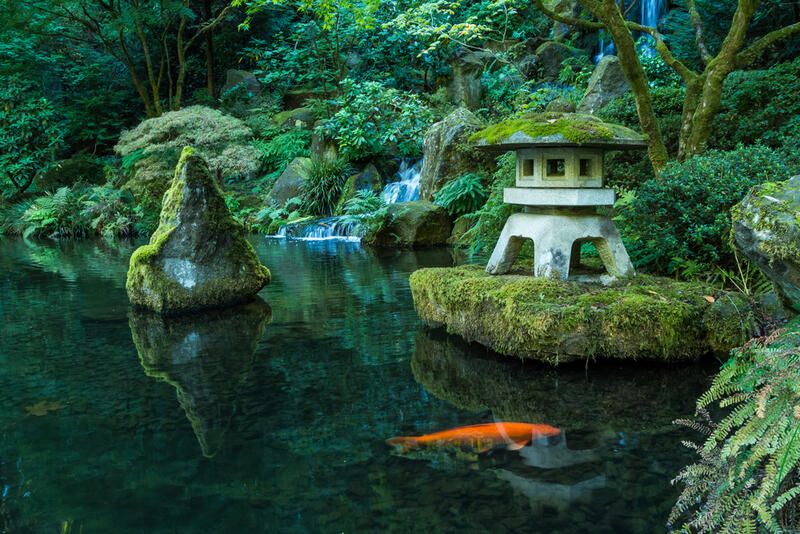
Japanese gardens have been attracting more and more attention lately. As life gets more hectic, the need to make our own private outdoor space a tranquil space to reconnect with ourselves and nature and refill our energy grows.


This is where Japanese gardens come in. Japanese gardens are traditional gardens whose designs are dominated by Japanese aesthetics and also Japanese philosophy.
All Japanese gardens have main, basic qualities that distinguish them from other gardens. If you're going for a Japanese garden design, you should have those qualities in mind.
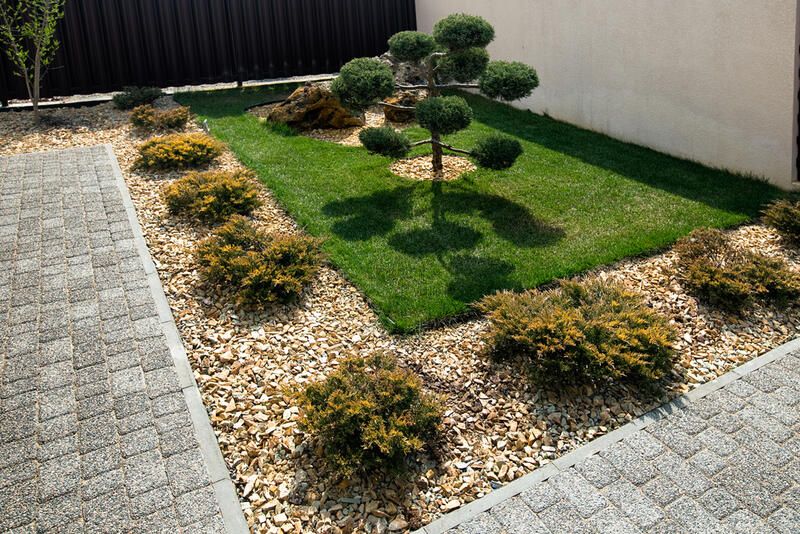
Japanese Garden Elements
Japanese gardens are very aesthetically pleasing, but they are not meant nor designed to just be beautiful. And this is something you should keep in mind while considering Japanese garden ideas.
The main idea with them concerns spirituality and philosophy. So natural elements are the main ingredients of a Japanese garden.
The most important of them are water, sand, and rocks. The best Japanese garden ideas will include those elements. And there are a lot of creative, authentic, and tranquil ways to incorporate them into your garden, no matter how small it is!
But they are not used or chosen randomly. Each element has a purpose.
Water
Water is such an essential element in Japanese gardens that it's either placed literally through a pond or more than one pond connected to imitate a stream.
Or symbolically, like in a rock garden, if water can't be found by arranging fine sand to look like a running river.
It's not just water by itself too, but a miniature representation of water bodies and their effect on their surrounding landscapes through adding certain elements to the water feature like worn rocks that appear like they have been eroded by waves, and pine trees.
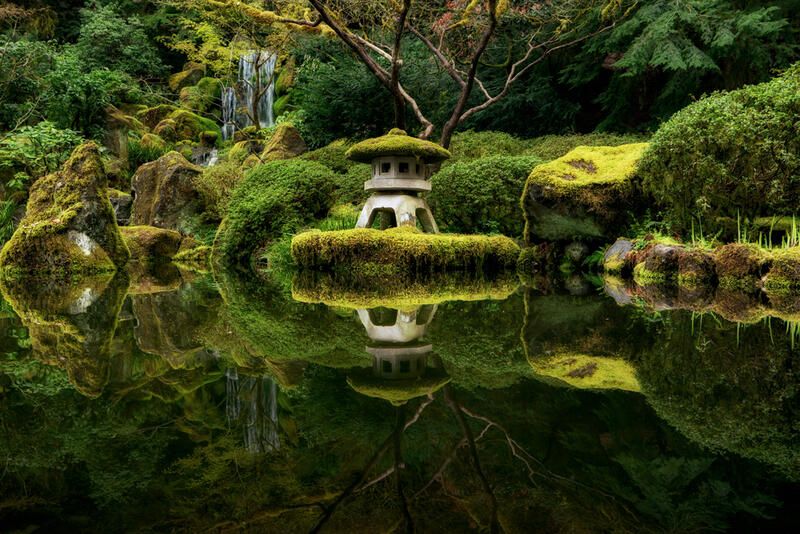
Rocks and Sand
The importance of rocks for Japanese gardens is such that they are capable of representing most things. Rocks should be planted firmly in the earth and arranged in threes, fives, or sevens.
They shouldn't be colorful, and their type depends on what they represent. They can represent mountains, valleys, and hills.
Small, rounded stones are used by water bodies, while rough stones are used as stepping stones. And as paving stones.
Sand is equally important. As fine sand is related to water and can replace it in a symbolic relationship. It can also represent a cloud pruning if arranged in a particular way.
Plants
The natural elements of the world are highlighted and represented in a very controlled manner in a Japanese garden. Growth is never left to chance.
Trees and flowers are selected very carefully in Japanese gardens to add color and texture. A tree is usually chosen for its autumn color, like cherry trees, Japanese privet, also known as a cloud or garden tree, and Japanese maples. Moss is used in most Japanese gardens as well.
It adds a visual ancient element, especially with moss-covered rocks, and all-year-round interest. It's best added to shady areas as moss doesn't handle foot traffic well.
Elm, pine, willow, heavenly/sacred bamboo, and cypress Japanese trees are also very usually used. Another feature of trees is their carefully controlled arching branches to reflect in the pond or ponds.
Maple, Azaleas, and Camellias are used sparingly for the changing seasons as they still have beautiful thick foliage long after early spring, during the fall and winter.
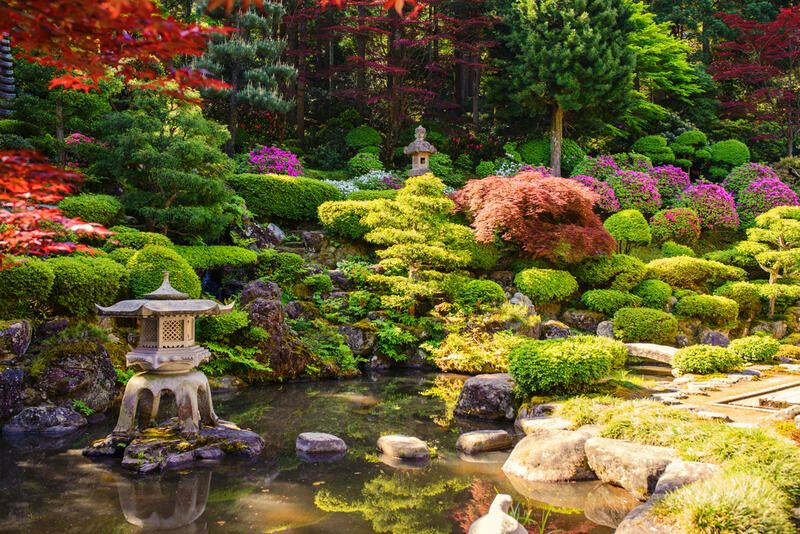
Fish
Japanese gardens make use of decorative fish to add color and movement to their scenes. The most used of those fish is the famous koi carp for their stunning colors. They add immensely to water bodies. Especially large ponds, if there is enough space in the garden.
Artificial Elements
Japanese gardens naturally reject artificiality in concept but allow it minimally. Especially when those elements are made out of natural materials like bamboo stalks or stone.
Bridges, gates, and water basins are popular. You can have a stone lantern, a stone water feature, a bamboo stalk gate, and fences.
Japenese Garden Types
There are a lot of different types of Japanese gardens that have historically been developed to serve different purposes and be viewed from different points of view.
They are also different like the terrain, and which element is highlighted.
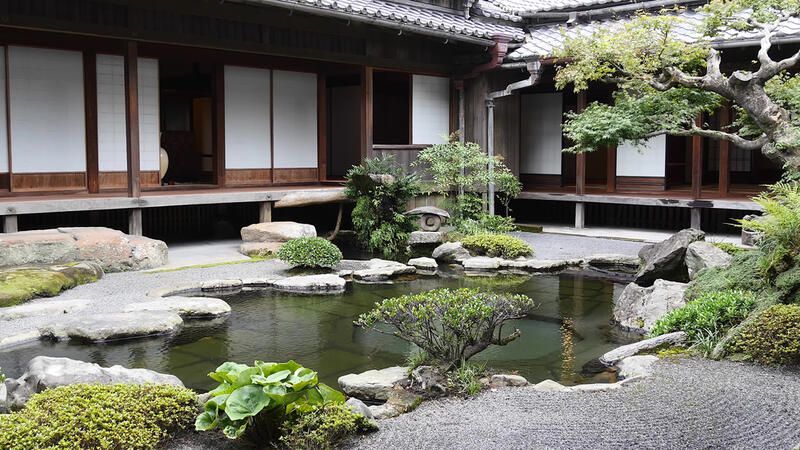
Tea Garden (Chaniwa)
Tea gardens surrounded tea houses and led them through pathways made of stepping stones. They were an integral part of tea ceremony houses.
They are made up of inner and outer gardens. Other than the stone paths, they are characterized by water basins, stone lanterns, and evergreen plants. Guests would use the stone basin for ritual cleansing before passing from the outer garden to the inner one.
And the lantern adds to the rustic atmosphere while also providing functional lighting.
Like the others, tea gardens are minimalistic with a focus on spirituality and retreat.
You can go fully in and adopt this Japanese garden idea for your backyard. Or you can pick some elements from it!
Hill Garden (Tsukiyama)
As one of the oldest garden types in Japan, hill gardens are referred to as man-made hills whose architectural form is a sort of miniature nature scenery.
This scenery includes most of the things valued in nature: hills, ponds, streams, stones, and paths. Paths are particularly important as the focal point of this type of Japanese garden is to create movement and facilitate quiet contemplation during strolls.
Bridges are also typically a key part of hill or pond gardens. With trees and plants surrounding it.
This is a particularly good garden idea if you have the space for it. Unlike other types, this one needs a larger space.
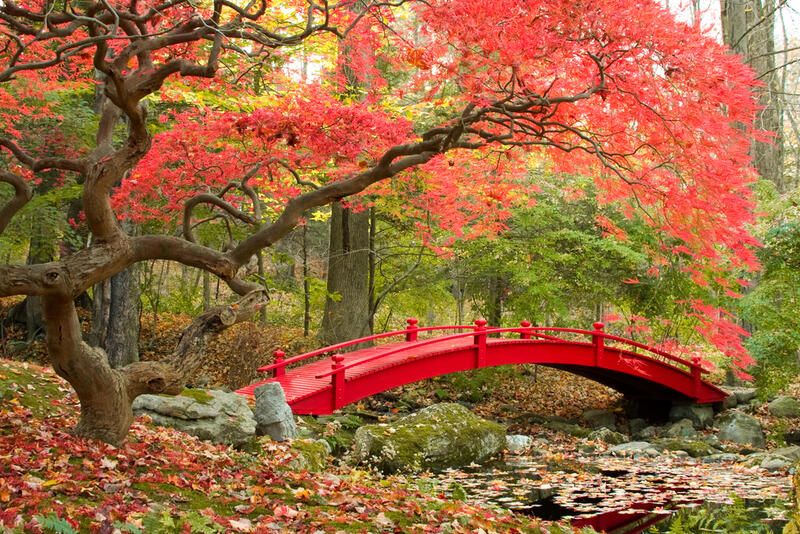
Dry Landscape Garden (Karesansui)
Also known as a zen garden or rock garden, dry landscape gardens focus on stone, gravel, and sand. How they are arranged together is what makes a zen garden.
In a rock garden, is no water feature factually, but as it is in Japanese culture, water is symbolized through the arrangement of rock forms to create a dry waterfall. The pattern of flowing sand and fine gravel imitates that of a dry river or stream.
There are naturally few plants with this type as well. This idea would be perfectly suitable if your live in a dry area prone to draughts. You wouldn't need to waste any water and still, you'll have the symbolic flow of it.
Stroll Garden (Kaiyushiki-teien)
There are subtle differences between hill gardens and stroll gardens, even if they have a lot of similarities. While hill gardens' focal point is creating a snapshot of wider nature, stroll gardens are created mainly for strolling.
While in hill gardens, the stone makes up a straight line, here there are winding, circular paths. This type also contains hills, ponds, trees, and flowers. Supposedly, in a stroll garden, the view should differ from one point to the other.
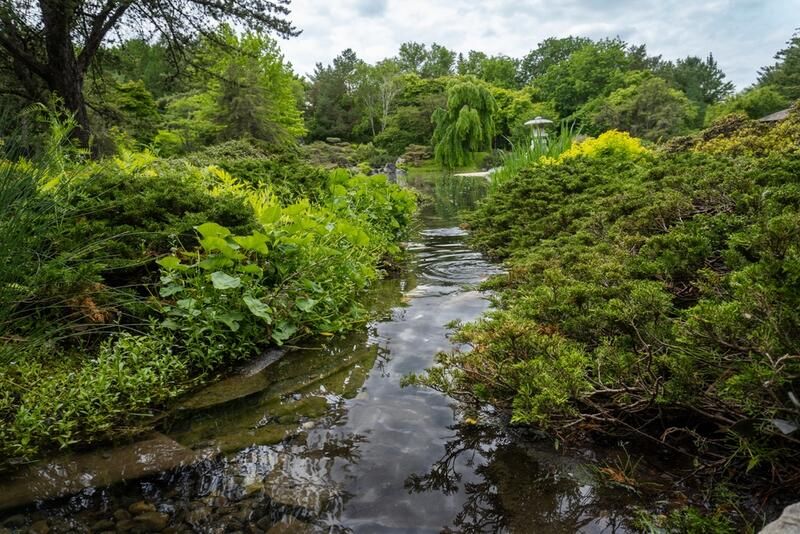
Courtyard Garden (Tsuboniwa)
Courtyard gardens are a mix between hill, tea, and zen gardens. There can be as many beautiful elements from other styles as possible. The style's key feature is just focused on a mid-point between the indoor and outdoor space in often walled, smaller spaces outdoor.
Bringing the indoors outside to connect with nature in serenity. And the best thing about this Japanese style is that it's perfect for a small garden.
Japenese Pond Garden (Chisen-shoyū-teien)
The main feature of this style is one large pond in the middle, surrounded by the natural scenery of trees and plants. This garden style is minimalist and low maintenance.
If not one pond, then a few smaller ones are connected, with surroundings like eroded rocks or rocks covered with moss. To highlight the pond/ponds.
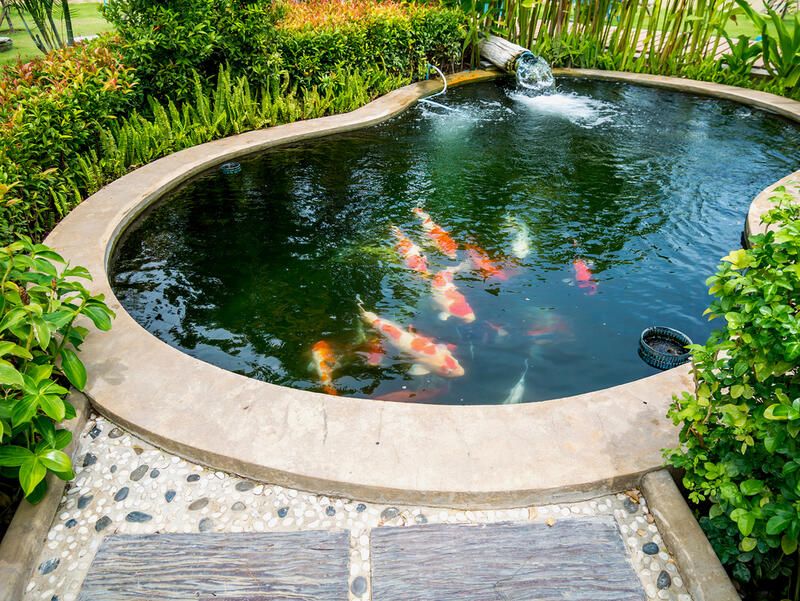
How to Incorporate Japanese Garden Elements In Your Garden
If you don't want to or can't adopt an entire Japanese garden type, but still want a Japanese-style garden, there are some important ways to use to incorporate the Japanese style by using its basic elements that you should have in mind.
Asymmetry
Japanese-style gardens aim to mimic nature. And while a lot of effort can be put into shaping plants, and trees, and arranging rocks, it's often done in an intentionally asymmetrical way.
Strict geometry and symmetry aren't garden features in Japanese gardens. So if you want that style, you should avoid it.
Instead, arrange your plants in odd-numbered groups with different, but harmonious, sizes. The key element is balance, not perfection.
Symbolism
The Japanese garden elements aren't arranged randomly. They are used and arranged in certain ways to represent organic shapes in nature in a miniaturized way. Large rocks are arranged on top of each other to represent a miniature hill or mountain.
Ponds and streams represent seas and oceans. Bonsai represents forests.
So it's not just the elements you use but how you use them and why. Understanding the primary function of a Japanese garden will make it easier for you to get creative and incorporate more elements without overdoing it and with understanding.
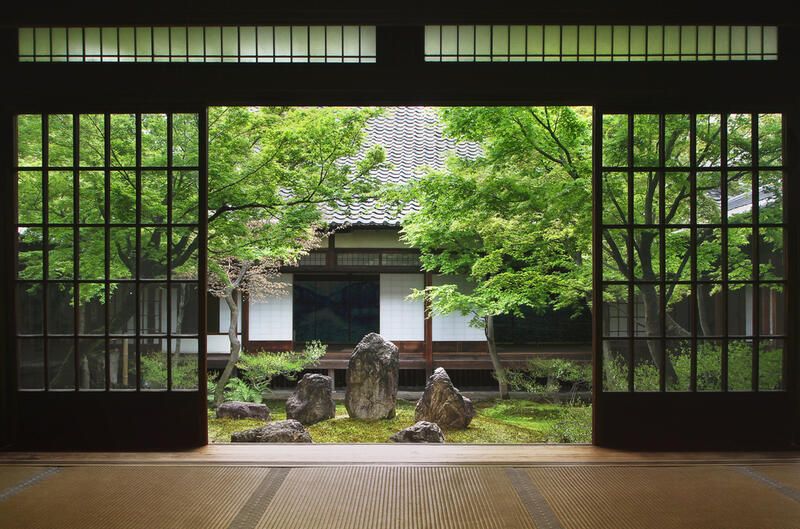
Focusing on the Unseen
In a Japanese garden, the unseen areas are as important as the scene. There should be a sense of mystery and deeper discovery in the garden. It's not all given away with the first look.
More Japanese Garden Ideas
Knowing this, you can dig up a ton of Japanese garden ideas for your outdoor spaces by mixing and matching those elements according to the Japanese garden style.
Here are more ideas!
Use a Zigzag Bridge
Zigzag bridges add a playful, interesting look to a garden. But it's also meaningful in Japanese garden ideas due to its relationship with legends and folklore.
According to legend, evil spirits can only travel in straight lines and so zigzag bridges protect you while crossing bodies of water.
Use Ornamental Grasses
Using Japanese-inspired ornamental grass is an easy way to get Japanese garden style. Especially around bodies of water, where it represents scenes of nature.
Another similar Japanese garden idea is using Japanese forest grass.
Japanese forest grass is best used underneath Japanese autumn trees to add to the look of a Japanese garden while remaining lowkey and low in maintenance.

Use Rain Chains
Rain chains are another playful detail that is added to many Japanese gardens to add character. They can be made out of bamboo too. Ornaments like this are great Japanese garden ideas because they are effortless and immediately add to the vibe!
Don't hesitate to contact shrubhub.com to get consultancy for your landscape. You can easily plan your entire garden and already know how it would look like in all circumstances!


